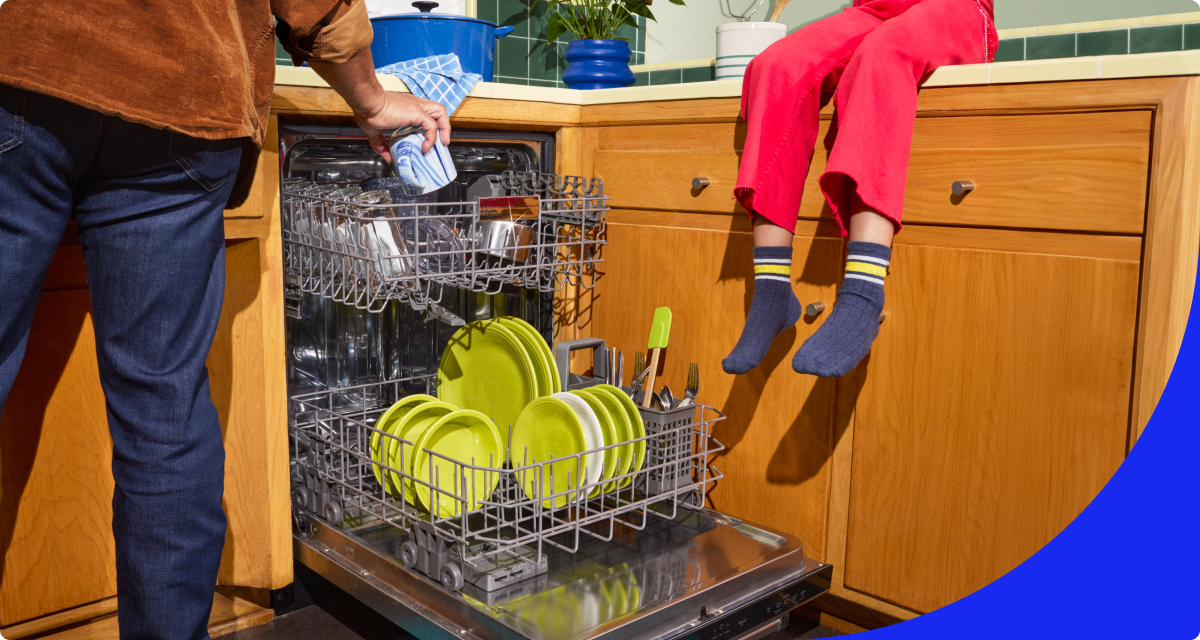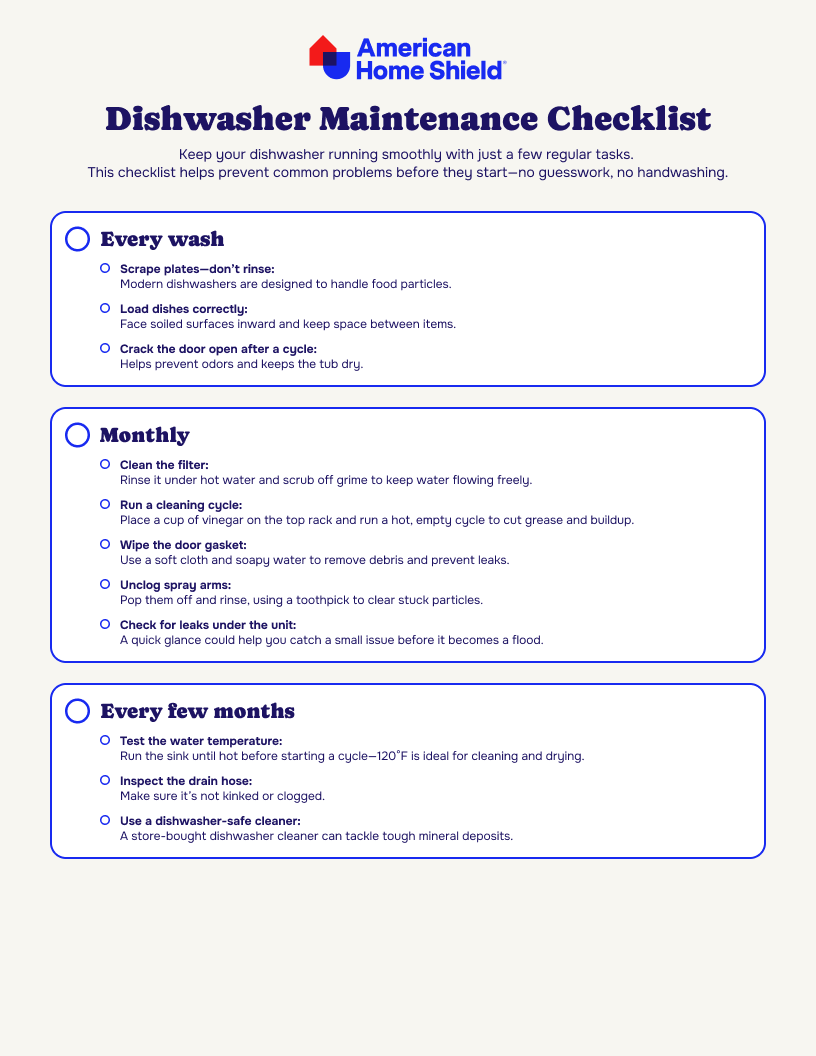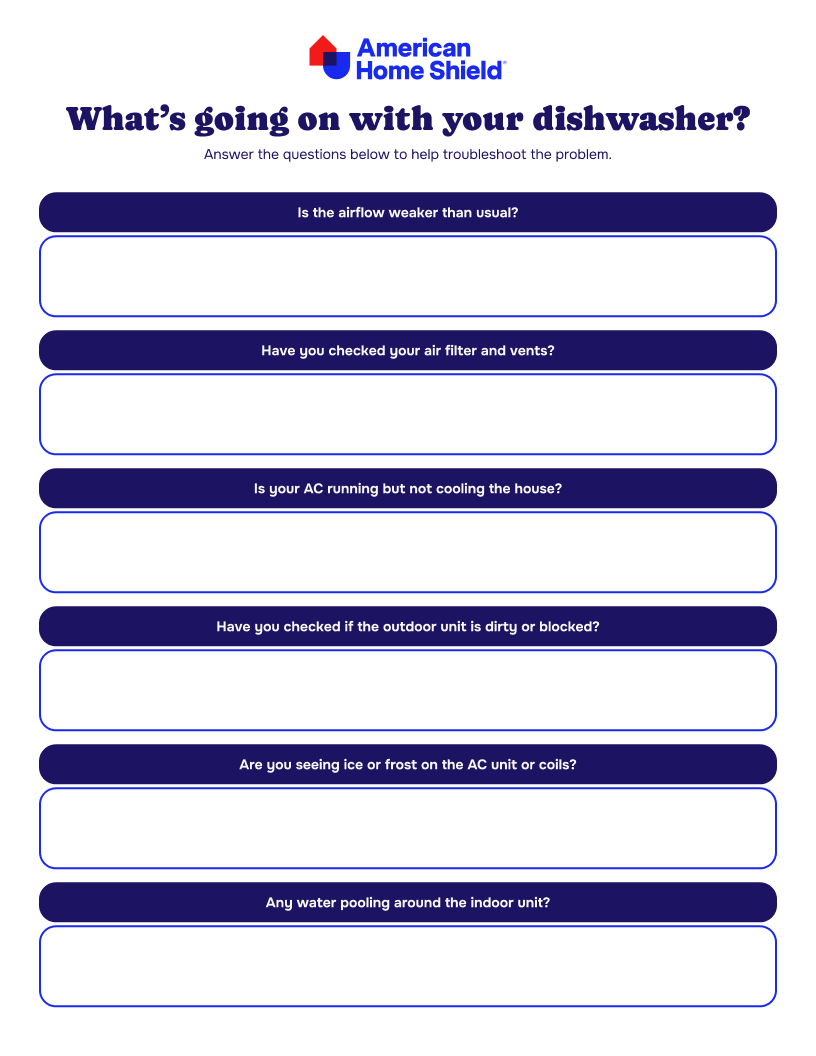Clean the filter regularly.
Once a month, remove the filter and rinse it under hot water. A clogged filter is one of the top reasons for dirty dishes and drainage problems.
There’s nothing more frustrating than your dishwasher not working. We’re here to walk you through the troubleshooting process step-by-step, so you can figure out what’s fixable and when it’s time to call the Pros.

Before we figure out why your dishwasher’s not working, it’s important to get up close and personal with your machine. Most dishwashers work the same way: they fill with hot water, spray it around to blast off food, then drain and dry.
Here are the key components to know:
Motor – Powers the pumps that circulate water through the spray arms.
Spray arms – Spin and spray water to clean dishes.
Filter – Catches food debris before it hits the drain.
Heating element – Heats water and helps dry dishes.
Detergent dispenser – Pops open during the cycle to release soap.
Drain hose – Sends dirty water out.
Float valve – Monitors water levels to prevent overfilling.
Door gasket – Seals the door shut to prevent leaks mid-cycle.
Your dishwasher not working can throw off your whole routine. Before you consign yourself to a lifetime of washing dishes by hand, or before you involve a repair Pro, here is a collection of some of the most common dishwasher issues and step-by-step dishwasher troubleshooting tips to help you get things back on track.
Let’s say you go to turn your dishwasher on and get… nothing. No lights, no hum, no cycle.
Symptoms:
Troubleshooting:
If you run a cycle and your plates are still crusty and your glasses are still foggy, it’s time to take a hard look at your machine.
Symptoms:
Troubleshooting:
If the cycle’s over but everything’s still soaked, it’s time to take a closer look.
Symptoms:
Troubleshooting:
Standing water in the bottom of the tub is unsightly—and can smell bad fast.
Symptoms:
Troubleshooting:

Stay ahead of breakdowns.
Grab our free Dishwasher Maintenance Checklist to keep your machine running smoothly.
Did you know households waste an average of 10,000 gallons of water a year through leaks? So if you think your dishwasher may be leaking, it’s time to act fast.
Symptoms:
Troubleshooting:
If your dishwasher isn’t singing its usual symphony (read: its noises feel new or loud), that often means something’s off.
Symptoms:
Troubleshooting:
When that squeaky-clean dish smell is replaced by something sour, fishy, or just plain gross, it’s time to investigate.
Symptoms:
Troubleshooting:
A frustrating and obvious problem is when your machine won’t run—or leaks mid-cycle—because the door won’t stay closed.
Symptoms:
Troubleshooting:

Not sure where to start?
Download our Dishwasher Diagnostic Worksheet to help pinpoint the problem fast.
While it can feel annoying or unnecessary, a little maintenance now can save you from major dishwasher problem solving efforts later. Here’s how to prevent common dishwasher issues:
Once a month, remove the filter and rinse it under hot water. A clogged filter is one of the top reasons for dirty dishes and drainage problems.
Use a damp cloth and mild soap to clear away food splatter and prevent leaks.
Use white vinegar or a dishwasher cleaner on an empty hot cycle to break down grease, soap scum, and hard water buildup.
Modern dishwashers are built to handle light food residue. Pre-rinsing can actually reduce cleaning performance.
Remove and rinse them every few months. Use a toothpick or wire to clear out any blocked spray holes.
Make sure you’re using dishwasher-specific detergent—never dish soap. Check labels to find the right type for your water hardness.
Let the kitchen sink run hot for 30 seconds to make sure the dishwasher starts off with heated water.
This prevents moisture buildup and keeps odors at bay.
Just know that even with careful, regular care, all appliances will wear down over time. Knowing how to fix a dishwasher, or who to turn to for Expert help when you’re in over your head, can make all the difference.
Additional reading:
Your Dishwasher Maintenance Checklist
Best Way to Clean Your Dishwasher
A dishwasher’s role in your home is simple: clean the dishes, without the fuss. So when things get complex it feels confusing. Whether you’re facing draining problems or a dishwasher that’s just not working, American Home Shield is here to help with real solutions—not runarounds.
With select plans, you can use video chat through the AHS app to connect with a live appliance Expert in real time. Your Expert will help with dishwasher problem solving and figuring out next steps. And if your dishwasher is still not working? We’ll send a independent, qualified repair Pro to handle the repair.
From minor hiccups to major breakdowns, one thing’s for certain: you’re not alone. American Home Shield is here to help you handle dishwasher troubleshooting with confidence and clarity.